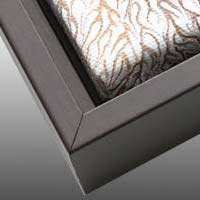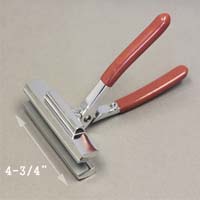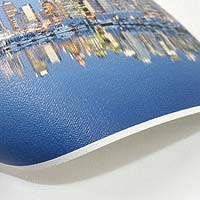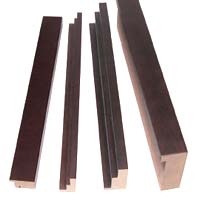C
Canvas A heavy-duty, tightly woven fabric; rolls of specialty canvas are used in inkjet prints to produce Giclée canvas prints. After they are printed, the canvas is treated with a protective coating that guards against scratching, and dust and water damage.
Order online:
Mounted Artist Canvas
Rolled Artist Canvas |
 |
| Canvas Board Refers to canvases that are wrapped around a thin board instead of stretched over a wooden frame. These canvases are sturdy due to the backing, but are generally constructed from lower quality canvas fabric. They are easy to frame in a regular picture frame due to their thin depth. |
Canvas Floater A style of frame ideal for a gallery wrapped canvas print or original painting. This frame overlaps the artwork from behind (instead of in front like a traditional picture frame), where the wooden frame of the canvas is affixed to the floater frame. The floater frame surrounds the canvas, separated by a gap of approximately 1/4 inch on each side, creating a “floating” effect. Floater frames are available in a variety of styles, including “stair step”, “tapered” and “L shape”.
View our large collection of canvas floater frames. |
 |
Canvas Pliers Used to stretch a canvas over and around a wooden stretcher bar frame. Once the canvas has been stapled to the back of one side of the frame, the next end of the canvas is held with the pliers and pulled tightly around the frame. While continuing to hold the canvas taut, staples are placed to affix the canvas to the frame.
Order online today: Canvas Pliers |
 |
Canvas print A canvas print (also known as a stretched canvas) is an image printed onto canvas, generally with an inkjet printer, which is then stretched, framed and displayed.
Order your custom canvas print today. |
 |
| Canvas Texture Canvas texture refers to the surface pattern or weave characteristic of canvas material used for painting or printing. In Giclée printing, canvas texture can be digitally replicated or physically added to the printing substrate to mimic the appearance and tactile feel of traditional canvas. The texture adds depth, dimension, and a sense of authenticity to printed artwork, particularly for reproductions of paintings or artworks originally created on canvas. |
Canvas transfer A process which lifts the image on a print off the paper support so that it can be transferred to a canvas mount.
Place an order online: Canvas Transfers |
| Card Stock Card stock is a type of thick, heavy-weight paper or paperboard commonly used in printing for applications requiring durability and stiffness. In Giclée printing, card stock may be used for producing high-quality prints of photographs, artwork, or marketing materials that demand a premium look and feel. Card stock comes in various weights, thicknesses, and finishes, making it suitable for a wide range of printing projects, including business cards, postcards, invitations, and greeting cards. |
| Center of Interest The center of interest, also known as the focal point or focal area, refers to the main subject or primary point of visual focus in a piece of artwork or photograph. In Giclée printing, the center of interest plays a crucial role in guiding the viewer's attention and conveying the intended message or narrative of the image. It is often strategically positioned or emphasized through composition, lighting, and contrast to draw viewers in and evoke emotional or intellectual responses. |
| Chain dot These dots of ink, otherwise called elliptical dots, which meet at the outer edges, creating a chain effect. The term may be used for any midtone ink dots that meet. |
Chop (1) Verb: To cut or slice in fluid, repetitive motion, generally wood, with a sharp, straight blade. A chopper is used to cut wood picture frame and stretcher bar moldings at 45 degree angles in preparation for assembly.
(2) Noun: an uncut length of picture frame moulding that is ready to be mitered and constructed. |
 |
| Chop Mark The signature of the printer, applied to the prints produced in that workshop using a stamp or embossing. Much like the artist signs each piece. |
| Chopper The machine used to cut picture frame moldings and stretcher bar lengths. It may be controlled manually or by a motor. The knife blades of the chopper are angled at 45 degrees and meet at a point. The result is a 45 degree angle cut on both sides of the wood beam. |
| Chroma Chroma, also known as saturation or intensity, refers to the purity and vividness of a color in an image. In Giclée printing, chroma is controlled by adjusting the concentration or saturation of colorants used in the printing process. High chroma colors appear bold, vibrant, and rich in hue, while low chroma colors appear muted, subdued, or desaturated. Managing chroma levels is essential for achieving accurate color reproduction and maintaining the visual impact and fidelity of printed artwork or photographs. |
| ChromaLuxe ChromaLuxe is the world’s leading manufacturer of high definition sublimatable photo panels. Through dye sublimation, images are infused directly into specially coated sheets of metal, wood, and table top panels to create the most vibrant, durable, and longest lasting photo medium in the world. |
| Chrome Chrome refers to the strength of a color when compared to neutral gray. Another word for "saturation". |
| Chrominance Chrominance, often abbreviated as "C" in color spaces like YCbCr or YUV, refers to the color information or colorfulness of an image, independent of its brightness or luminance. In Giclée printing, chrominance plays a critical role in determining the overall color accuracy, saturation, and vibrancy of the printed output. Adjusting chrominance levels allows printers to control the intensity and purity of colors, ensuring that printed images accurately reproduce the intended hues and tones with fidelity and consistency. |
| Clamping A process of fastening two items together with a strong grip. Generally, a special tool called a clamp is used, which is tightened by twisting or pumping a lever until the required grip is achieved. In picture framing, clamps may be used to affix art temporarily to a board, or hold picture frame corners in place until an adhesive dries. |
| Clamps The tool used in fastening two items together with a strong grip. The tool is tightened by twisting or pumping a lever until the required grip is achieved. In picture framing, clamps may be used to affix art temporarily to a board, or hold picture frame corners in place until an adhesive dries. |
 |
| Climate control Climate control is important for preserving original and significant pieces of art. Changes in humidity and temperature can cause artwork to expand, warp, discolor or begin to flake. In addition to framing with high quality, archival-grade materials, climate control will protect the artwork for many generations. |
| CMYK A common color mode term used by graphic artists and print technicians. CMYK stands for Cyan, Magenta, Yellow, Black, and identifies the color cartridges commonly used in ink jet printers. |
Coated wire A hanging wire popular in picture framing that is covered in a clear or opaque plastic coating. Coating the wire gives it some additional strength, protects it from fraying and makes it safer to handle.
Order online:
Plastic-coated Wire |
| Cold lamination Lamination is a process of permanently applying a clear plastic coating to paper. In cold lamination, the cover's adhesive is activated by pressure rather than heat. It is a safe option when laminating heat-sensitive images (any image that could be negatively affected by the application of heat), primarily papers printed with inkjet printers. Cold lamination also provides better UV protection than hot lamination. |
Color Calibration The measurement or adjustment of the way a device responds to the colors input to its system. In fine art printing, it is important that the designer's monitor is calibrated corrected so as to display the digital image as close to its original digital capture as possible. It is significant to note, however, that in the case of a reproduction, the original digital scan or photograph will not be identical to the physical artwork in color saturation.
Read more about color matching in art reproduction. |
| Color Depth Color depth, also known as bit depth, refers to the number of bits used to represent each pixel in a digital image. It determines the range of colors that can be displayed or reproduced in the image, with higher color depths allowing for more shades and nuances of color. In Giclée printing, color depth directly impacts the quality and fidelity of printed images, with higher bit depths enabling smoother gradients, better color accuracy, and finer detail reproduction. Common color depths used in printing include 8-bit (256 colors), 16-bit (65,536 colors), and 24-bit (16.7 million colors). |
| Color Filter Array A color filter array (CFA) is a pattern of color filters placed over the individual pixels of an image sensor in digital cameras and scanners. The most common CFA arrangement is the Bayer filter, which uses alternating red, green, and blue filters to capture color information. In Giclée printing, the color filter array plays a crucial role in capturing accurate color data from the original artwork or photograph, which is then processed and reproduced using inkjet printing technology. |
| Color Harmony Color harmony refers to the pleasing arrangement or combination of colors in an artwork or design that creates a visually balanced and aesthetically pleasing result. It involves the careful selection and arrangement of colors based on principles such as complementary, analogous, or triadic color schemes, as well as considerations of hue, saturation, and value. In Giclée printing, achieving color harmony is essential for ensuring that printed images evoke the desired emotional or visual impact and maintain a sense of coherence and unity. |
| Color Management Color management is the process of controlling and maintaining consistent color reproduction throughout various stages of the digital imaging workflow, from image capture and editing to printing and display. It involves the use of standardized color spaces, color profiles, and calibration techniques to ensure accurate color representation across different devices and media. In Giclée printing, effective color management is crucial for achieving color accuracy, fidelity, and consistency in printed output, regardless of the printing equipment or materials used. |
| Color Management System A color management system (CMS) is a software-based solution or set of tools used to implement color management techniques and workflows in digital imaging and printing. It includes features such as color profiling, color space conversion, and device calibration to ensure consistent and accurate color reproduction across different devices, software applications, and output media. In Giclée printing, a color management system is essential for maintaining color accuracy and fidelity throughout the printing process, from image editing and proofing to final print production. |
| Color Picker A color picker is a graphical user interface tool used to select and choose colors from a color palette or spectrum. It typically allows users to interactively sample colors from an image or specify colors using numerical values for hue, saturation, and brightness. In Giclée printing, color pickers are commonly used in digital imaging software for adjusting color balance, applying color corrections, and selecting ink colors for printing, providing users with precise control over the color reproduction process. |
| Color Range Color range refers to the extent of colors that can be perceived or reproduced by a given device, medium, or color space. It encompasses the full spectrum of visible colors, including variations in hue, saturation, and brightness. In Giclée printing, the color range of the printing system, ink set, and substrate determines the range of colors that can be accurately reproduced in printed images. Printers strive to achieve wide color ranges to faithfully reproduce the rich hues and tones of the original artwork with precision and fidelity. |
| Color Rendering Index The color rendering index is a quantitative measure of a light source's ability to accurately reproduce the colors of objects compared to a natural or ideal light source. It is expressed as a numerical value ranging from 0 to 100, with higher values indicating better color rendering. In Giclée printing, color rendering index may be considered when evaluating lighting conditions for viewing prints, ensuring that colors are perceived accurately and consistently under different lighting environments. |
| Colorant A colorant is a substance or material that imparts color to another material or surface by absorbing or reflecting certain wavelengths of light. In Giclée printing, colorants are the inks or pigments used to create printed images on paper, canvas, or other substrates. Different types of colorants, such as dye-based or pigment-based inks, offer varying characteristics in terms of color accuracy, lightfastness, and durability, influencing the quality and longevity of printed output. |
| Colorimetry Colorimetry is the science and technology of measuring and quantifying colors based on their perceptual attributes, such as hue, saturation, and brightness. It involves the use of color measurement instruments and mathematical models to analyze and describe colors in terms of their spectral properties and human perception. In Giclée printing, colorimetry plays a crucial role in color management, color matching, and quality control processes to ensure accurate and consistent color reproduction in printed output. |
| Complementary Color Complementary colors are pairs of colors that are located opposite each other on the color wheel. When combined, complementary colors produce a neutral gray or white color, and when placed next to each other, they create strong visual contrast and enhance each other's intensity. In Giclée printing, understanding complementary colors is important for creating dynamic and visually striking color compositions, as well as for color correction and color grading purposes. |
| Complementary colours A pair of colors that produce black when combined (or in the case of colored light, white). Placed side by side, this pair creates the greatest possible contract between the colors. Complementary color pairs in the RGB model: red and cyan; yellow and blue; magenta and green. |
| Compression Artifact A compression artifact is a distortion or visual anomaly that occurs in digital images or video as a result of data compression techniques used to reduce file size. Common compression artifacts include blocky pixelation, blurring, ringing, or color banding, which can degrade image quality and reduce detail and clarity. In Giclée printing, avoiding compression artifacts is important when preparing digital images for printing to ensure that printed output retains high-quality, crisp detail, and accurate color reproduction. |
| Contact Print A contact print is a photographic print made by placing a negative or transparency directly in contact with photosensitive paper and exposing it to light. This results in a print where the size of the image matches that of the original negative or transparency, producing a one-to-one reproduction without enlargement. Contact prints are commonly used in traditional darkroom printing processes and are valued for their fidelity to the original image and fine detail reproduction. |
| Continuous Tone Continuous tone refers to an image that contains a smooth gradation of tones from light to dark without any abrupt transitions or visible dots or pixels. It is characteristic of analog photography and printing processes, where variations in exposure or ink density produce a seamless range of shades and hues. In Giclée printing, achieving continuous tone reproduction is essential for creating high-quality prints with lifelike detail and smooth tonal transitions. |
| Contrast Relative difference between the brightest and darkest parts of an image. A contrast control adjusts the peak white level of a display device. High contrast displays as a highly noticeable separation between the light and dark shades in the image. |
Cotton A soft fiber made from the cotton plant. It is highly versatile, and in picture framing is used in mat boards, fine art papers and canvas.
This white vegetable fiber grown in warmer climates in many parts of the world, has been used to produce many types of fabric for hundreds of years. Cotton fabric feels good against the skin regardless of the temperature or the humidity. |
 |
Cotton rag Paper made from 100% cotton fibre. Unlike most paper made from wood pulp, cotton rag paper is stronger, more durable, acid-free, and suitable for archival purposes.
Order online:
100% Cotton Matboard
Stretched Artist Canvas
Rolled Artist Canvas |
| Craze The fine cracks that appear along the surface of acrylic sheeting and within hardened varnish when too much pressure has been applied. |
| Curves Curves, also known as tone curves or contrast curves, are graphical representations of the tonal values in an image and the adjustments made to them. They allow users to adjust the brightness, contrast, and color balance of an image by manipulating the distribution of tones across the tonal range. In Giclée printing, curves are commonly used in image editing software to fine-tune the exposure, contrast, and color balance of prints, enabling precise control over the appearance and visual impact of the final output. |
| Cyanotype Cyanotype is a photographic printing process that produces cyan-blue prints using a light-sensitive iron-based solution. It involves coating a surface, such as paper or fabric, with a mixture of ferric ammonium citrate and potassium ferricyanide, then exposing it to ultraviolet light to create a chemical reaction that results in a blue image. Cyanotype printing is valued for its distinctive blue tones, simplicity, and versatility, and it is often used for artistic purposes and alternative photographic techniques. |

